How to Play
Fast Football is a 1977 card game that takes the sport of football and simplifies it as much as possible. Before play begins, set up the football field game board and separate the offensive play cards from the defensive play cards (and shuffle both decks). Flip a coin to see who gets first possession of the ball. The ball is placed on the 20 yard line and the yard marker at the 30.
When a new possession begins, each player draws four cards from their respective deck (the player on offense draws offensive cards and the defensive player draws from the defensive deck). The offensive player takes a look at his or her cards and plays one of them face up next to their draw deck. Early on in the drive, these cards will likely be a mix of passes and runs of various lengths. After the offensive player plays his or her card, the defensive player looks at their hand and tries to find a card that can stop it (possible defensive cards include pass incomplete, tackle at line of scrimmage, and tackle + 5). Even if they can’t stop the offensive player from successfully executing their play, they must play one of their four cards (you can play something pretty much useless like a punt block even though it makes no sense and would be a terrible play call in a real football game).
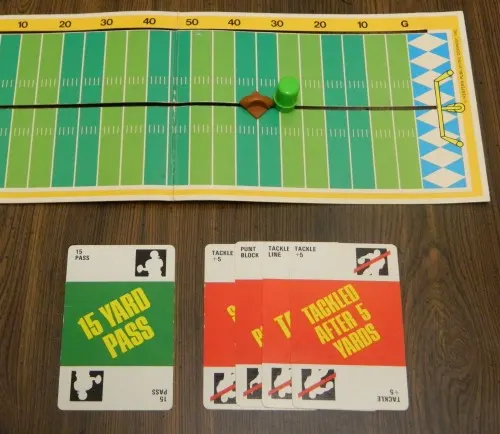
On first down at the twenty, the offensive player attempts to throw a 15 yard pass. The defense has nothing that can stop it so they will just play whatever card they think is least valuable. If the defense had an incomplete pass card, the offense would pick up zero yards. This play results in a first down because the ball moved past the yard marker (the game actually comes with a real marker but my copy didn’t so I just used a random green playing piece as a stand in).
Once both players have played their cards, they draw a new one from their deck to replace it and the result of the play is determined. See the following lists for the possible results of the play:
Offensive cards:
- 5/10/15/20 yard pass-Ball is advanced five, ten, fifteen, or twenty yards (depending on which one you play) if the pass is successful.
- Pass bomb-Automatic touchdown unless the defense plays the bomb block card.
- 5/10/15/20/30 yard run-Ball is advanced five, ten, fifteen, twenty, or thirty yards (depending on which one you play) if the run is successful.
- 40/50 yard punt-Ball is advanced 40 or 50 yards (depending on the card played) if successful and the opposing team takes over possession. Useful only on fourth downs when you don’t want to give your opponent good field position.
- 20/30/40 yard field goal-Ball must be within 20, 30, or 40 yards of the end zone (depending on the card played) to use these cards. Three points is scored unless the defensive team plays a field goal block card. These cards should only be played on fourth down.
Defensive cards:
- Tackle at line-Cancels any running play (no matter how long), offensive team gains no yards.
- Tackle + 5/10-Stops any running play of 5/10 yards or more, keeping the run limited to either five or ten yards (depending on which card you use). For example, if the offense calls a 20 yard run but the defense plays a tackle +5 card, the run will be held to just five yards instead of twenty.
- Fumble-Stops all running plays. The defense takes possession at the line of scrimmage (where the play began).
- Punt block-Stop all punts, defense takes possession of the ball at the line of scrimmage (where the ball was punted from).
- Field goal block-Stops all field goal attempts. Offense scores no points and the defense takes possession of the ball at the line of scrimmage.
- Pass incomplete-Cancels all passing plays except for the bomb card. The pass is incomplete and the offense gains no yards on the play.
- Interception-Doesn’t work against the bomb card but otherwise if played on a passing play, the defense takes possession of the ball at the destination of the pass (if it was a twenty yard pass attempt, the defense will get the ball twenty yards past the line of scrimmage).
- Bomb block-The only card that can stop the pass bomb card. If played the bomb is incomplete and the ball doesn’t move.
If a play succeeds (the defense played something that couldn’t stop the play the offense ran), move the ball the correct amount of yards. If the ball moves past the yard marker, the offense gets a new set of downs (it is now first down again) and the yard marker is moved ten yards past the new spot of the ball. If not, it is now the next down and both teams play new cards. The offensive team has four total downs to get a first down (move the ball past the yard marker), kick a field goal, or punt. If the offense fails to do so, they turn the ball over on downs and the defense takes over the ball at the line of scrimmage. When the other player takes possession of the ball (via a fumble, interception, turnover on downs, or a touchdown or field goal by the opposing team), the two players swap decks (the player that used to be on offense gets the defensive deck and vice versa), re-shuffle them, and draw four cards each. Play continues in the exact same way as before.
For scoring, any play that takes the ball onto or across the goal line is a touchdown. Any team that does so scores seven points (extra points are considered freebies in Fast Football). The only other way to score is to successfully kick a field goal using one of the field goal cards. Field goals are worth three points. The player who has scored the most points after an agreed upon time wins the game.
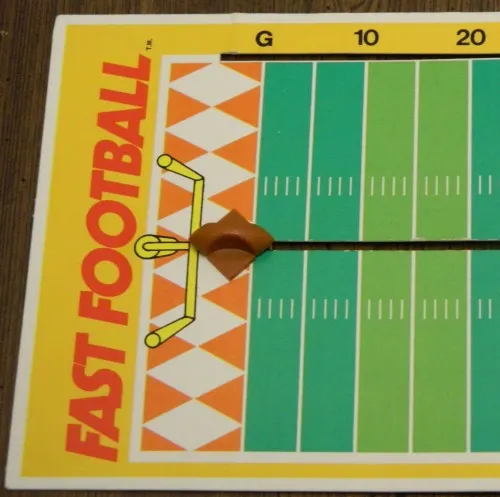
Since the ball has moved into the end zone, the result is a touchdown and seven points for the offensive team.
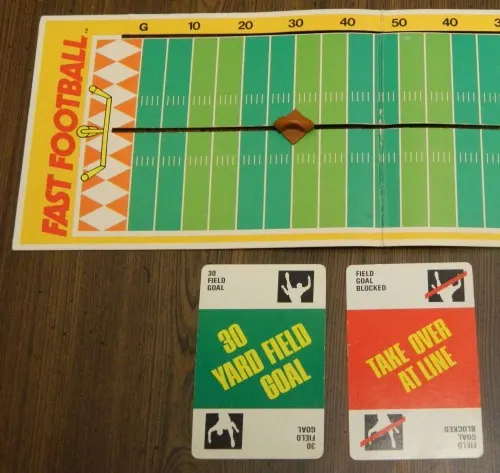
Since the ball is on the thirty yard line and the offensive team has a 30 yard field goal card, they can attempt a field goal for three points. However, the defensive player just happened to have the field goal block card so the kick was blocked and no points were scored.
Note: As of this review’s publication, Board Game Geek’s description of the rules is incorrect. They say that both players play their cards face down and reveal them at the same time. The rules state that the offensive player is supposed to play a card face up and then the defensive player plays one of their cards. Otherwise, it would be even more difficult to stop the offense because you wouldn’t even know what type of card to play.
Review
As you probably already know, we here at Geeky Hobbies absolutely love football. Both Eric and I are huge Green Bay Packers fans and we both are even shareholders of the team (for those who don’t know the Packers are a publicly-owned team). I love football with my whole heart but even I can’t love a game like Fast Football. It is a horrible game (one of the worst we’ve reviewed on Geeky Hobbies), mainly because it takes an extremely complicated sport and tries to distill it into a simplistic card game but completely fails to do so.
Football is a very strategic sport, filled with complicated schemes and game plans that take an entire week to fully prepare. Fast Football is not, the offensive player simply guesses what cards their opponents has and calls a play that they think their opponent can’t stop. The defensive player has very few decisions to make (unless the offense called a shorter play and they need to decide if they should aggressively stop the play or wait for a longer play to use their good cards), they simply respond to the offense’s play. If they happen to have a lot of incomplete pass and tackle at line cards, they might be able to stop the offense. Otherwise, the offense will pretty much march down the field until they score a touchdown (it is very difficult to stop the offense on three or four straight plays).
Also, in Fast Football there are so many situations that make absolutely no sense (including some things a football team would never do in real-life). Among the problems you might encounter, you have to go for it on fourth down if you don’t have a punt card (even if you are still at the twenty yard line and haven’t moved an inch), you can’t kick a field goal if you don’t have a field goal card (even if it is fourth down and you don’t have any plays that can gain you the yardage you need), the defense will often call ridiculous plays like a punt block on first or second down if they don’t have anything useful to stop the play (in real life this would almost certainly lead to a free touchdown or big play for the offense but somehow the defense just holds them to whatever was on the offensive card in this game), the offensive team could just flat out be screwed if the defense gets an interception or fumble card early or on their first draw (the offense pretty much has to play a mix of runs and passes unless they get extremely lucky), and punts and field goals drawn early in a drive just sit in your hand wasting space and limiting what you can do (my opponent almost had to kick or punt on first down once because three of their first four cards were field goal and punt cards).
I was victim to a lot of these quirks in the games I played to do this review. On one drive, I was actually pretty lucky on defense getting the other player into a fourth and five situation on the 50 yard line (sadly enough that is a good example of defense in a game of Fast Football). However, he then drew the pass bomb card on fourth down and I didn’t have the bomb block to stop it. I got him into a bad situation but he wound up scoring because of a very lucky card draw. In addition, he once drew an interception card on his initial draw meaning that my drive was pretty much automatically going to be stopped eventually (and since I threw on first down, he got great field position). I guess I can’t complain too much because one time, I drew the pass bomb card on my first draw and got a free touchdown out of it on my first play.
The biggest problem with Fast Football is the strange oddities (like free interceptions, not being able to kick or punt without a card, etc.). What makes the game even worse is the fact that with a little play testing (I know the game was released in 1977 so of course they probably didn’t do any of that) and a few rules changes, Fast Football actually could have been a decent simplistic football game. If I ever play the game again (which I almost certainly will not), I am adding some of my own rules to the game. First of all, I would allow players to get a free 40-yard punt or 20-yard field goal whenever they want without needing a card to do so (since those are pretty much automatic in football today unless you have a terrible kicker or punter). On fourth down, you could simply say I’m punting, the ball would move forty yards forward, and the team on defense takes over possession. In terms of field goals, if you are twenty or less yards from the goal line you can just take the three points instead of having to go for it on fourth down if you don’t have a field goal card. I would then combine the punt and kick cards together (they could work as either a punt or kick) and make them modifiers instead. For example, you could draw a +10 punt/kick card which would add ten yards to a punt or kick (so you could kick a field goal from the thirty yard line or punt the ball fifty yards). This would be a much better solution than having to rely on drawing a punt or field goal card or being forced to go for it on fourth down.
Also, Fast Football needs some balancing so I would also propose a new defensive card type and a rule change to the most OP offensive play. The previous owner of the copy I used changed one of the incomplete pass cards to a sack worth -10 yards. I think that is a great idea and I would actually make it two or three cards in the deck (some of which would be five yard sacks instead of ten) instead of just one. This at least gives the defense a chance to stop a drive. Also, I would change a successfully “blocked” pass bomb attempt into either an automatic interception or even a pick six and have two or three cards that can stop it instead of just one bomb block card. Since a bomb in football is a very risky play to call (they often lead to interceptions if the ball is under or over thrown or the receiver isn’t on the same page as the quarterback), there should be some risk to calling it in this game (which there isn’t because even if the defense just happens to be lucky enough to have the bomb block card it is just an incomplete pass anyway). You shouldn’t just get a pretty much free touchdown without having to take a risk. I’m sure there are other things that could be done to balance the game even better. However, any game that requires a bunch of rules changes to make it even somewhat playable is not a good game.
There is pretty much no strategy to Fast Football at all, the game almost completely relies on card draw luck and playing the right card each turn (which is pretty much a blind guess for the offensive player). However, the offense has three or four downs to pick up just ten yards and it is almost impossible for the defensive player to have cards to stop three or four straight plays. Looking at the card type list would make you think the defense would have the advantage (a large chunk of them stop all yardage or take the ball away), but they don’t because the offense will eventually call something that you can’t stop (a pass when you only have run cards or vice versa). Since you discard your cards after a possession ends, you can’t even store up good cards for later in the game or when you really need a stop. Card draw luck basically determines whether the offense or defense is going to dominate each drive.
Just so I can say I said something nice about Fast Football, I do like that the game is very flexible from a play time standpoint. You can play as long as you’d like (even just a couple of possessions each, which is most likely how long it will take before you realize this is a terrible game) as long as you agree on an amount of time to play. The only other “positive” is that Fast Football is very simplistic and easy to learn and play. However, the game is way TOO simplistic. Last year, Eric reviewed a game called Jukem Football which is a much better football card game even though it is also a pretty simplistic game. If you like football but want something less complicated than the classics (like Paydirt and Bowl Bound), don’t buy Fast Football. Buy Jukem Football instead.
Final Verdict
Fast Football is an awful version of something I love dearly, football. If this was my first introduction into the sport, I don’t know if I would be a football fan right now because this game is terrible. The only people I could even see it being passable for are kids who aren’t ready for the tougher football games (and there are still better options for them as well). I spent a dollar for this game at a thrift store and it wasn’t even worth it. Do not buy Fast Football, if you are looking for a good simplistic football game buy Jukem Football instead.

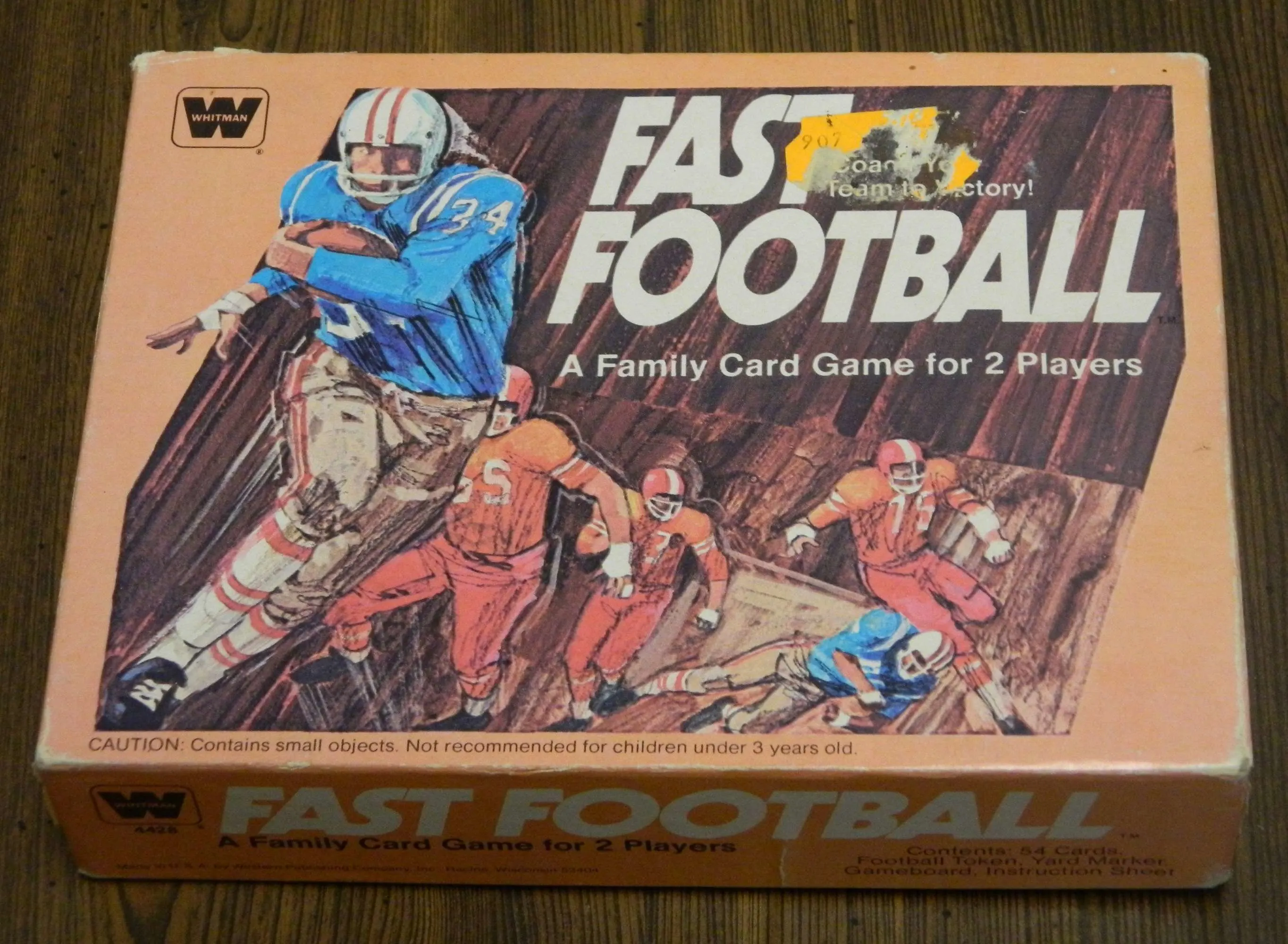
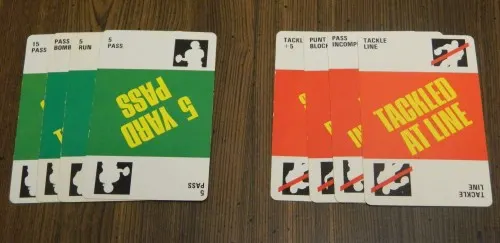
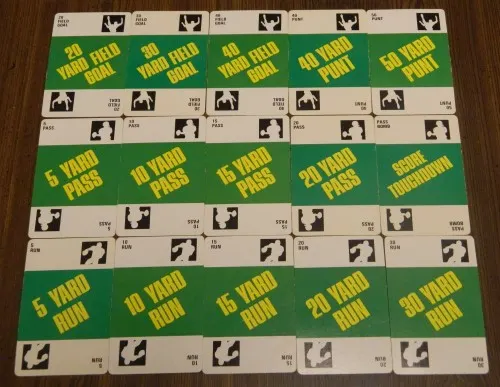
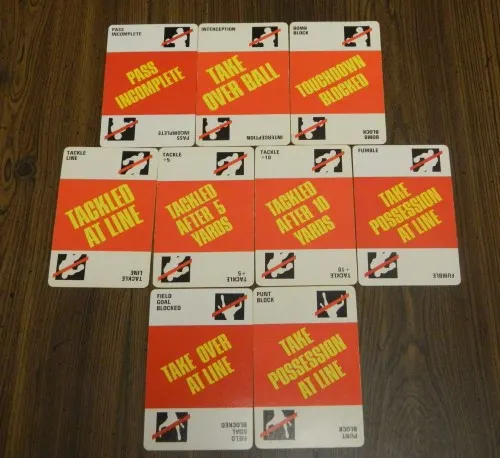
Matt
Saturday 25th of November 2017
Hello - Since you are such an avid fan, I wonder if you will me a favor. Does it reference in the booklet the illustrator or box cover?
Appreciate your help. Thanks.
Eric Mortensen
Saturday 25th of November 2017
Hello.
At this moment I can't get to my copy of the game but when I am able to I will look at the instruction booklet to see if it mentions the game's illustrator. Without looking at the booklet I would guess that it doesn't give the artist's name. I say this because older board games (Fast Football was created in 1977) tended to not give credit to the people who worked on the game. Unless the designer or artist was really well known, they generally weren't mentioned on the box or the instruction booklet. That is a shame because the creators should have been given credit for their work. The good news is this doesn't seem to be as big of a problem with board games today as most publishers now give credit to the designers and artists that worked on the game. When I am able to find my copy of the game I will update you but I wouldn't hold out a lot of hope that the game gave credit to the artist.
I wish I could have been of more help.